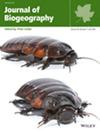Impact of Pleistocene Climate on Diversification and Distribution of Congeneric Freshwater Crustacean Species
Abstract
Aim
The climatic oscillations of the glacial–interglacial cycles significantly influenced species diversification, playing an essential role in shaping the current patterns of biodiversity. However, the effects of the Pleistocene climate on species diversification and their current distribution are poorly understood for the Southern Hemisphere and some taxonomic groups, such as invertebrates. Here, we explore the role of Pleistocene climate changes in the diversification and distribution of four species of South American freshwater crustaceans.
Location
Southern South America.
Taxon
Genus Aegla (Aeglidae).
Methods
We performed phylogenetic analyses, estimated genetic diversity and neutrality indices for Aegla alacalufi, Aegla neuquensis, Aegla platensis and Aegla uruguayana using nuclear and mitochondrial sequences. We used the mitochondrial genes to estimate divergence times, calculate historical demography and reconstruct the ancestral area range. We also estimated current and past potential distributions using ecological niche modelling.
Results
Although all species studied had their diversification influenced by Pleistocene glacial cycles, the Patagonian species A. alacalufi and A. neuquensis, which were directly influenced by the glacial ice cap, appear to have benefited from lower sea levels and melting of glaciation ice. As for the species A. platensis and A. uruguayana, their diversification was affected by the dry and cold climate on the continent during the glacial period.
Main Conclusions
Our study unveils the intricate interplay between Pleistocene climatic fluctuations and the evolutionary history of freshwater crustaceans in South America. Distinct phylogeographic patterns were observed in Aegla. Some underwent significant diversification due to glaciation, while the cold, arid conditions of the continent shaped others. These findings underscore the crucial role of past climate dynamics in the distribution and genetic diversity of species. As freshwater ecosystems confront escalating threats, our study highlights the urgency for conservation measures and continued research to unveil species' adaptive mechanisms in the face of climate change.

 求助内容:
求助内容: 应助结果提醒方式:
应助结果提醒方式:


